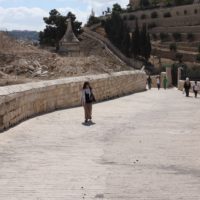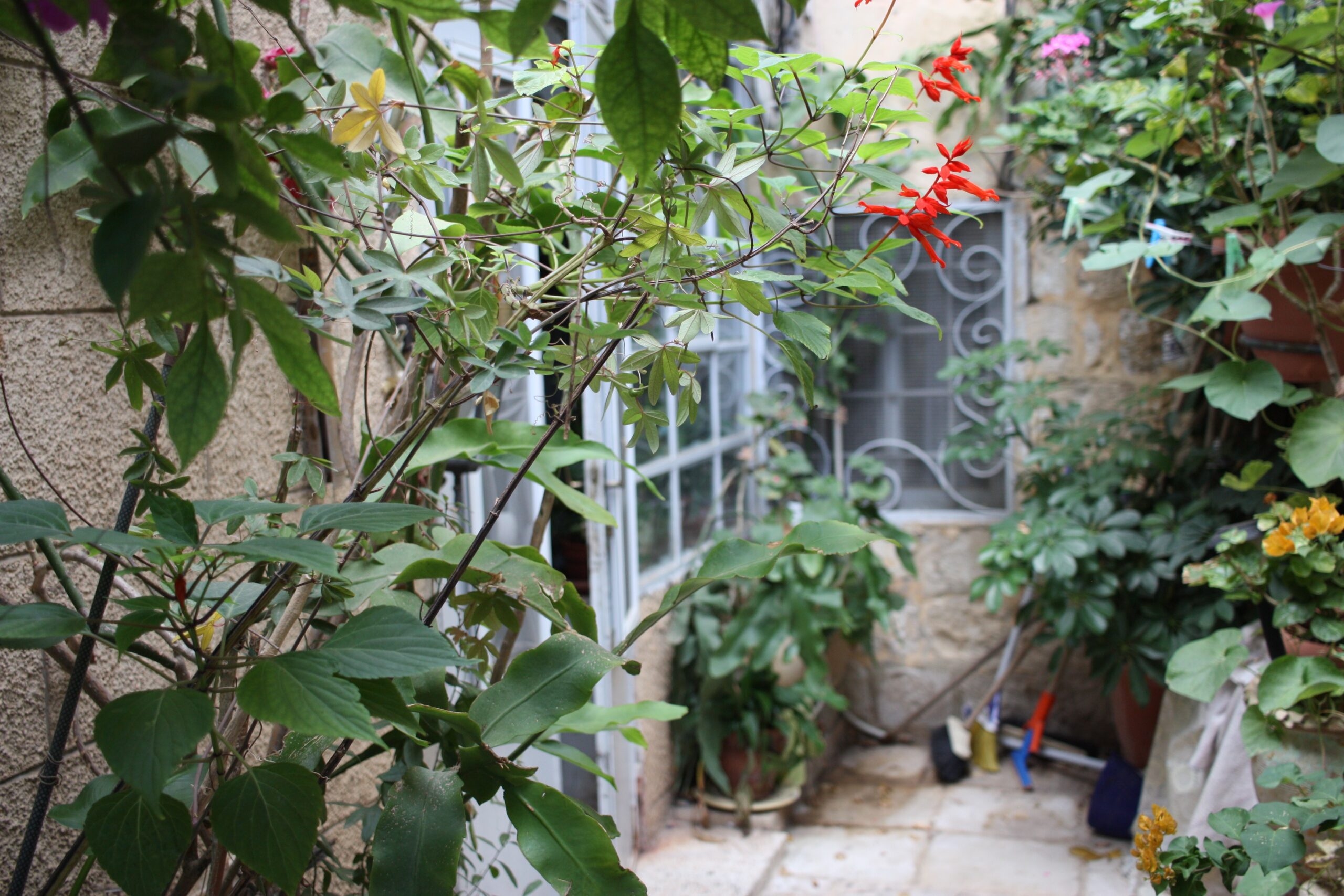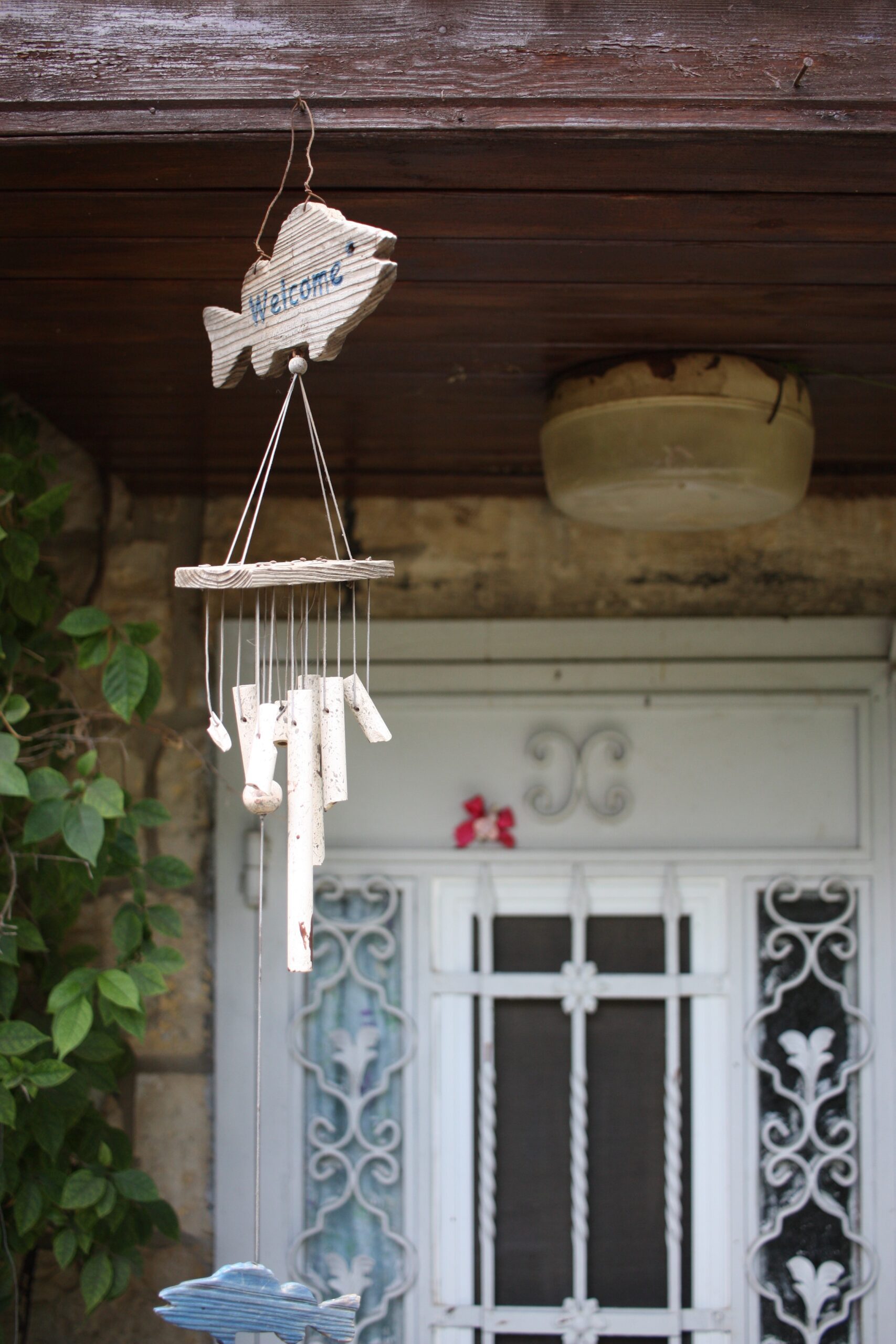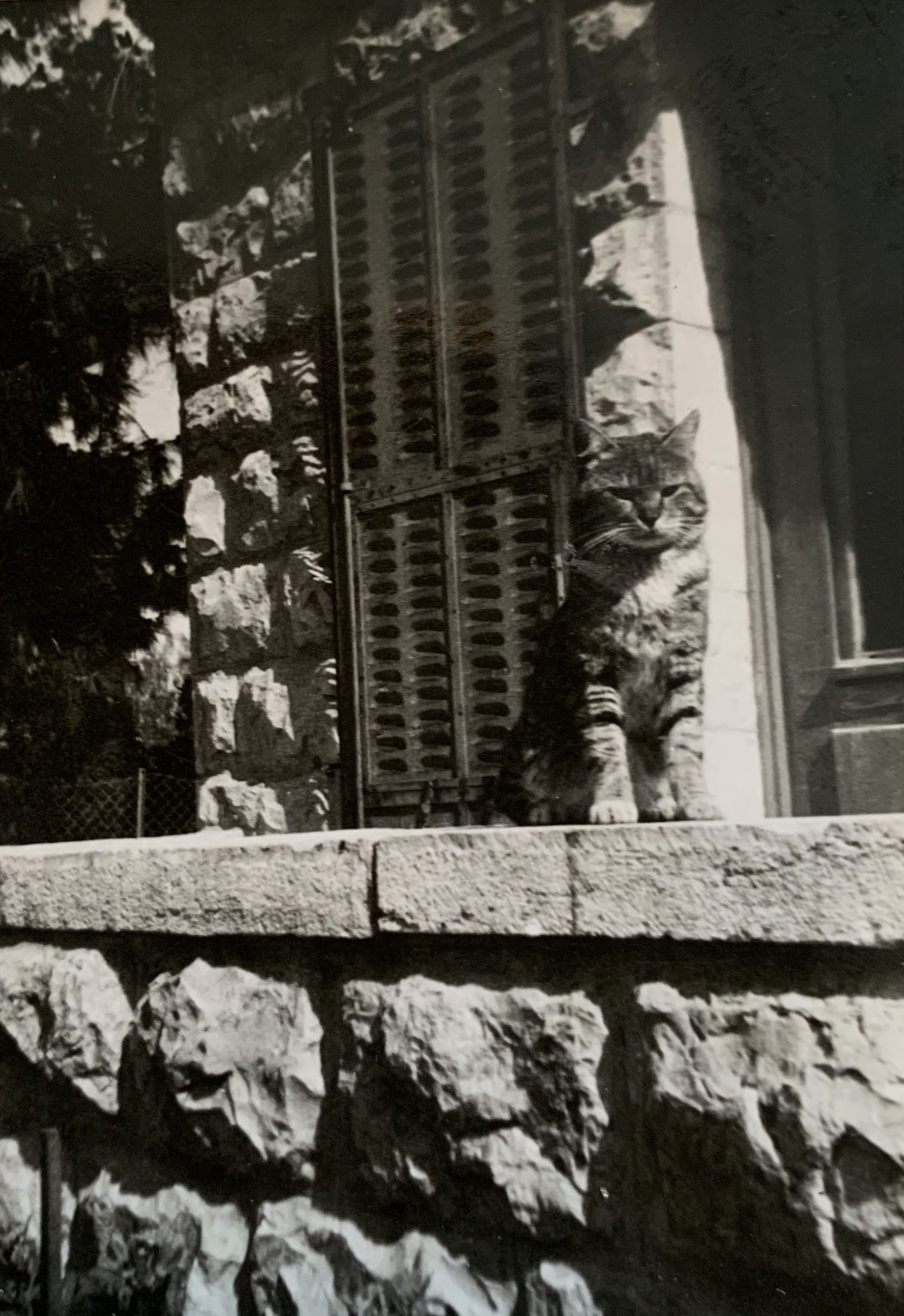Artist Vic Lepejian sketched a ripe pomegranate onto an unburnished vase when my husband David and I entered the doorway of his art studio located on Jerusalem’s Via Dolorosa—the street where Jesus is said to have taken his last steps before dying on a cross. I found myself walking on my tiptoes trying not to disturb Vic. David signaled to me and I followed his hand: a mosaic entitled “Broken Jerusalem,” made of broken plates and mugs, hung on the wall across from the cash register. The mosaic is Vic’s lamentation over the violence that has plagued the Holy Land for centuries, including the Armenian Quarter of Jerusalem, where Vic lives.
On a later visit, he told us that imitations of Armenian pottery are sold in hundreds of Israeli and Palestinian souvenir shops and on street corners near holy sites. Yet, there are no replicas of “Broken Jerusalem” to be found. The ceramics that make up the mosaic were individually painted with different sites from Jerusalem’s skyline, broken, and then pieced back together similar to how I shoved mismatched puzzle pieces together as a child, hoping to create a cohesive landscape. I cut my pinky touching one of the edges of a plate. The bright paint contrasted with the broken pieces reminding the viewer of Vic’s ability to find joy even in a place of destruction—a facility that Armenians know very well.
When we decided to travel to Jerusalem, I didn’t immediately tell my Grandpa George that we were visiting his childhood hometown. Every trip to my grandparents’ house in Lansing, Michigan, where they retired after George ended his professorship, has involved observing how he copes with his anxiety: pacing back and forth as the sound of his clicking slippers echoes throughout the living room. Had I called, I feared that he would have listed every possible terrorist attack that could happen, or provided statistics surrounding the increase in stabbings that he read about in one of the six newspapers delivered daily in English and Arabic. Instead, I sent our flight itinerary to him in an untitled email with the brief note: “I promise we will be safe.” George never replied. Instead, he sent six travel guides, three National Geographic maps, and two DVDs about Jerusalem that we never watched. I called him the night before our morning flight for last minute tips. He could not recall his address or any landmarks. George offered one bit of advice: go to the pottery shops and purchase the Armenian pottery that he remembered from his childhood.
Jerusalem’s skyline was painted onto the plate that I bought for my grandparents. The plate appeared identical to one of the ceramics Vic had used in “Broken Jerusalem.” The dirt on my hands smeared onto the clay, leaving traces of my fingerprints that I later removed with an eraser. Though the architecture of Jerusalem is made up of muted shades of natural stone, his buildings are depicted in color, both pastel and vivid; I failed to appreciate the uniqueness of the city’s buildings until seeing Vic’s paintings.
David had opened his wallet for shekels when I noticed a canvas taped on the side of one of the glass shelves. Vic apologized that the canvas was too long to fit into any standardized frame sold in the States. The piece was called Death and Rebirth, a phrase that provides perhaps the best synopsis of the history of the Armenian people. Mount Ararat—a snow-capped mountain with two inactive volcano cones, the type of peaks that I have never been able to paint, no matter how many art classes I take—overwhelmed the background of Vic’s mural. Mount Ararat remains a national symbol for Armenians, featured in various national emblems like the national coat of arms. According to the book of Genesis, Noah’s Ark landed on Mount Ararat after the Great Flood, which for Armenians, establishes a holy status for the land.
In Moses of Chorene’s History of Armenia from the 400s CE, Hayk, the founding father of Armenia, fought a mythic battle with the Babylonian leader, Bel, at the foot of Ararat to save his people from oppression. Since country borders were redrawn following World War I, Mount Ararat has not been part of the Armenian territory. The snowcapped peak looms over the Armenian capital city of Yerevan—an omnipresent reminder of the home that was taken from them.
As Vic continued to paint a basket of pomegranates onto a flower vase, a salesman who appeared a few years younger than my grandpa emerged from the backroom to check us out. As an attempt at small talk, I asked if he had known George Gazmararian. “Yes,” he answered, while peering over at my husband, David, who stood in the doorway scrolling through photos on his camera, which let out an audible click with each one he passed. When I said that I was George Gazmararian’s granddaughter, the salesman took off his glasses, approached me, and held my face delicately, as if I were a rare artifact belonging to the Holy Land.
“Yes, yes, yes,” he said. “You look just like him.” He spoke Arabic to the woman in the backroom, organizing shelves of ceramics; I recognized the harsh tones of the language from hearing George speak to my Grandma Ruth. The way his hands shook, I knew that the salesman was as shocked as I was. “I am Michael. Your grandfather and his family lived with my family in the house attached to ours.” Motioning for us to follow, Michael said that he would show us where George once lived—the house that Michael still called home.
“Small” is the only word George has ever used to describe his childhood home. I imagined his house in a variety of places, on a street corner that neighbors passed on their way to work, but which they never gave a second glance— a building that simply blended into their city. Michael led us down several cobblestone paths that we had not yet explored. He pointed to the gate guarding the graveyard, and told us, with ease, “That’s where your great-great grandparents are buried.”
When the Arab Israeli War began in 1948, the violence forced two-thirds of Jerusalem’s Armenian community to abandon their homes, including my grandpa and his family. My grandpa and his brothers were told by their mother to take one bag apiece. Instead of packing his favorite material possessions in a backpack, my grandpa took his cat, along with a stack of his favorite books. His memory of this time period is hazy. He cannot remember where his family escaped to, only that they stayed with friends outside of the city before he returned to school. He does remember that many Armenians found refuge with other families in the St. James Cathedral, just as Armenian refugees had temporarily taken shelter there after escaping the Armenian Genocide in Turkey in 1915.
Shortly after the Arab Israeli War, at the age of eighteen, my grandpa moved to Asheville, North Carolina, where he entered Warren Wilson College to study business and paid for school by feeding pigs on his college campus. After receiving college scholarships, his brothers fled to Amsterdam and Amman, respectively. Their parents encouraged them to leave in order to pursue their education and escape potential violence. My grandpa has never specified why his parents stayed in Jerusalem, other than that they considered it to be their home. The next time he saw his parents again, he had been married to my grandma Ruth for ten years.
George keeps a photo album of letters from his father, who never left Jerusalem. Occasionally, he pulls the album out long enough to recognize his father’s handwriting, but never long enough to read the letters. One visit, I searched for the letters in my grandpa’s office while he was asleep. Instead, I found a photo of my great grandmother’s open casket in St. James Cathedral. Her body was covered in freshly picked flowers and wrapped in a blanket cross-stitched with iconography of the crucifixion of Christ.
Jerusalem’s St. James Cathedral makes up two-thirds of the city quarter, and is dedicated to two Christian saints: James the son of Zebedee, considered to be the first of Jesus’ apostles to be martyred—which historians speculate occurred where the church stands—and James Minor, who is thought to have been the brother of Jesus, stoned to death after being thrown from the temple mount and surviving the fall.
Jerusalem’s quarters—divided by religion: Christian, Armenian, Jewish, and Islamic—are tied to a tragic religious history. Similarly, throughout history, with genocide commemorations and recognizing military defeats, Armenians tie their faith to sorrow. And based on the iconography in the cathedral, the Armenian Orthodox Church seemed to identify more with the agony of Christ on the cross versus His resurrection. In stepping into the cathedral, my melancholic nature seemed validated which was new to me; nothing like it had existed in the evangelical southern town where I grew up.
I grew up in Winston Salem, North Carolina—a town famous for being the birthplace of Krispy Kreme doughnuts, and for tobacco factories, which are now being transformed into loft apartments for Wake Forest students and biotech laboratories.
Later, I attended Salem, an all-women’s college, which is walking distance from downtown. Salem also functions as a living history museum comprised of buildings where Moravian settlers lived centuries ago. Several of my elementary school field trips involved visiting Salem where we observed potters, tailors, and gunsmiths use methods designed centuries ago.
Employees wore petticoats and bonnets even during the most humid Carolina summer days. Tourists occasionally knocked on my dorm, mistaking it for part of the museum. Occasionally, between classes I would visit the candle shop to smell the freshly poured beeswax candles made by the same process used in the eighteenth century.
Like Salem, I experienced Jerusalem as a city frozen in time. Both caused me to focus more on understanding the past versus living in the present.
When Michael asked, “Did George teach you Armenian?” I shook my head. I heard Armenian only from listening to my grandparents’ conversations. They argued back and forth over breakfast when George wanted extra bread, while Ruth insisted he eat foods rich with antioxidants—a diet tip for managing anxiety that she read in one of her favorite health magazines.
Each Christmas, Ruth sent my family a loaf of gata containing a quarter wrapped in tinfoil. Whoever found the coin in their slice of bread was guaranteed one year of good luck, which was the only Armenian tradition my family followed, mostly because the bread was amazing. One year when I found the coin in my slice of bread, I unwrapped the foil and used the quarter for a gumball at the Food Lion near my childhood home.
Back then, traditions outside of my immediate family seemed void of meaning. Back then, being Armenian simply meant having the hardest last name for teachers to pronounce when taking class attendance. I wanted a name like Martin, Ketner, or Davis. One that didn’t cause the pharmacist to say, “Will you repeat that,” three times before realizing I said “Z” instead of “D.” Back then, instead of a year of good luck, I wanted a shorter last name, to have skin as light as my friends who fixed their eyeliner and brushed on bronzer during lunch hour because no one ever asked them, “What are you?” At a predominately white Baptist high school infamous for scandals involving students skipping chapel for lattes and getting high on cough syrup in the parking lot before Bible class, my skin tone made me one of the few mascots for diversity. I have long suspected that for this reason I was cast as a servant in my high school’s play. No matter how many spray-on tans my friends purchased during prom season, I was always a shade darker, which, perhaps, only stood out to me.
To commemorate the one-hundredth anniversary of the Armenian Genocide, there were drawings of forget-me-not flowers posted throughout the Armenian Quarter in business windows and spray-painted on the walls of souvenir shops. I stopped to take photos of this next to the monastery, in the church graveyard, and on a school bulletin board as we walked past. I told David about my visit to the Project SAVE Armenian Photograph Archives in Watertown, Massachusetts, years before, when the head archivist explained the flower’s symbolism. The black pistil represents the suffering that Armenians endured during the Armenian Genocide. Between 1914 and 1923 in Turkey, Armenian men, women, and children were marched to mass graves in the Syrian Desert, or were massacred in their homes like my great-grandma’s father and brother.
To me, the pistil of the forget-me-not also represents the suffering that Armenians continue to endure. The Turkish government still refuses to officially acknowledge the Armenian Genocide despite overwhelming evidence, facts, and testimonials. This denial is a wound inflicted upon the collective Armenian identity. Ottoman soldiers destroyed Armenian churches and villages and confiscated property. Today, nothing in Turkey tells the stories of the lives lost, including those of my ancestors. According to the scholars and tourist companies I have contacted about visiting Turkey, villages like the one where my great-grandparents lived were destroyed to remove evidence of the massacres.
The lilac petals symbolize the unity of the Armenian communities across the world. Following the genocide, two thousand Armenian refugees relocated to Jerusalem, where the St. James Cathedral functioned as a hospice for pilgrims. The dark violet petals signify the five continents in which survivors found new homes, like my grandmother’s parents, who relocated from Turkey to Detroit. This color is meant to recall the vestments of the Armenian Apostolic Church, which differed from the European denominations in its opposition to proselytism. Meaning, church membership is limited to Armenian Christians. When David and I tried to enter St. James Cathedral, David was not able to go inside because he is not Armenian and also because he was wearing shorts. I went in and stood at the back of the church, watching as the priests sang in Armenian, imagining how my dad must have felt going to services conducted each week in a language he did not understand. As we left the church, I scraped up the skin of my palms from pressing them against the cathedral’s walls while listening to the clergy sing in a language that, in a previous generation, could have been my mother tongue.
Vic told us that in 1917, the British military discovered monuments in disrepair after taking over Jerusalem from the crumbling Ottoman Empire. The first Military Governor of Jerusalem, Ronald Storrs, found himself in charge of rebuilding the city, and grew especially concerned by the condition of the Dome of the Rock—the Islamic site where Muhammad is said to have ascended to heaven, and where Jews believe that Abraham prepared to sacrifice his son. Three Armenian families from the western Anatolian city of Kütahya were recruited to repair the Dome of the Rock. Leaving the Turkish city helped them escape the genocide.
After the Armenians arrived, the lack of funding and resources cancelled the renovation project. The artists opened up a workshop on Jerusalem’s Via Dolorosa called Dome of the Rock Tiles in honor of the project they never completed. In 1960, the Dome of the Rock was repaired using tiles imported from Turkey.
George’s childhood home, it turns out, is located on one of the narrow alleys outside the monastery. My grandfather never told me about the flowers that bloomed around his childhood home, or about the water fountain, or about the iron gate that guarded his home with an intricate geometric design that looked like a family crest. Ivy crept within the cracks of the two-cinderblock buildings that sat behind the gate. I did not know where the garden began or ended as the plants circled around the house. I took photos of the doorways, both decorated by the flowers and wind chimes at the entrance, and of the ceramic fish hanging from fishing line. I took a step back to study the cinderblock structure George once called home.
I tried to picture George watering the plants and playing soccer in the garden with friends. But the image in my mind’s eye was like a still-life painting—there was no movement. Picturing him felt no different from looking at the sepia-toned photos in the albums stacked by his desk; I did not know how to push the past to the present.
Michael’s wife came outside while on the telephone and waved to us. Covering her phone, she told her husband that their place was too messy for us to go inside. Thinking of the piles of laundry that awaited me when we got home, I understood. My grandpa told me once that every night he falls asleep thinking of his childhood home. Standing there, I pondered which parts of his home he missed most.
Three months before my great-grandmother’s death, Grandma Ruth recorded an interview with her mother. I listened to the cassettes for the first time in a vacant dry cleaner’s parking lot because I could not wait to listen to them back on my college campus. Standing with people who knew my grandfather and his home in a way that I never will, I found myself thinking about an exchange between Ruth and her mother during the interview:
“When you left home and came to America with your sister, cousins and aunt, do you remember feeling afraid? Were you happy?”
“I remember not having any feeling.”
I expected a spiritual awakening, or a sense of finding home. Instead I found a numbness. Perhaps my sorrow is inherited, the only thing I have that connects me to my ancestors.
When I was young, my grandma told me that Armenians are distant descendants of Noah. Back then, I considered the lineage to be a blessing. I did not grasp the gravity of Noah’s family witnessing the destruction of the world.
The more I learned about the Armenian Genocide and the various times in history that Armenians have been driven out of their land, I questioned if the relation to Noah made us more prone to experiencing and witnessing the evil of which man is capable—to learning how to recover from what appears unrecoverable.
I thought of the foreground of Death and Rebirth on the morning when I missed a meeting at work to get the outline of Mount Ararat tattooed—or, as my mother put it, “branded”—onto my right inner forearm. The foreground of the canvas contained a map of Armenia shaded with grey and black, like hardly pressed charcoal. There were splotches of red, like blood, over the map. Some blotches were spread apart, others bled together. Each blotch represented the Armenian villages and regions subjected to extermination. Pressing my fingers against the canvas’s rough ceramic shards, I thought of my grandparents: a woman whose parents survived genocide, and a man who escaped war for a better life. I began to wonder—are my grandparents connected not only by love, but by the atrocities they witnessed against the Armenian people, by their desire for a homeland?
The guest tattooist from Czechoslovakia and I were the only ones in the shop as the tattoo needle injected ink into my forearm. He did not ask where the mountain I gave him a picture of is located, but he did ask what it meant. I said, “hope” as more of a question than an answer.
When we visit George and Ruth in Lansing, I rarely see George because of the hours he spends checking his stock portfolio, or walking in the mall before getting his senior discount at McDonalds for a cheeseburger. Like my father, he thrives with having routine. Every memory that I have of him without his anxiety has taken place at the Armenian restaurant nearby his house. Whenever George speaks Armenian and Arabic to the restaurant owner, I imagine the childhood stories they exchange, and their opinions about the land disputes between Armenia and Azerbaijan. When we sit in classic diner booths across from each other, his concerns over the American economy temporarily disappear. The employees have a cultural understanding that his colleagues in college business departments have never understood. What he has endured would not surprise the restaurant staff, because to be Armenian is to be a survivor of atrocity. In an overcrowded college town with fast food chains on every corner, I often wonder if this strip mall is where he feels most at home. Here, in this Armenian restaurant, George can speak his mother tongue and open the door to the scent of chaimen and manti that once filled his house in Jerusalem, when, as a child arriving home after school, he felt his cat brushing against his ankle.
***
Photographs provided courtesy of author.








